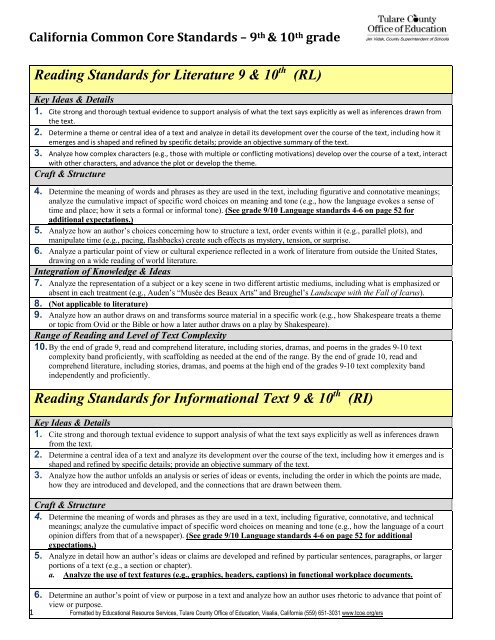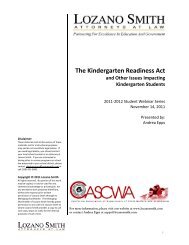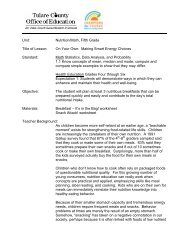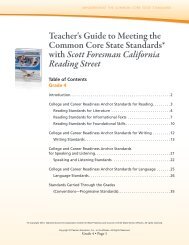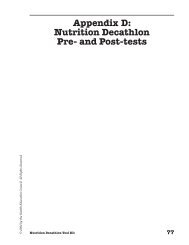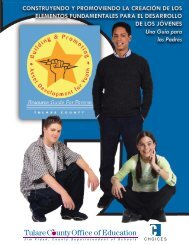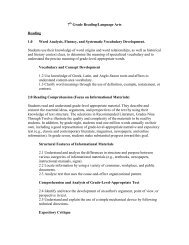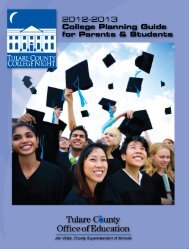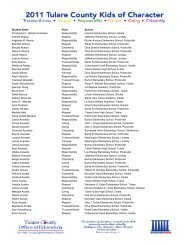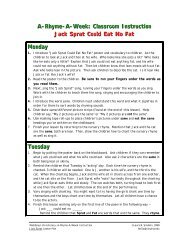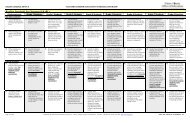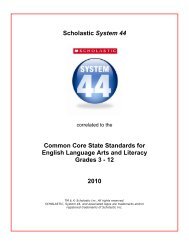Grades 9 & 10 - Tulare County Office of Education
Grades 9 & 10 - Tulare County Office of Education
Grades 9 & 10 - Tulare County Office of Education
Create successful ePaper yourself
Turn your PDF publications into a flip-book with our unique Google optimized e-Paper software.
California Common Core Standards – 9 th & <strong>10</strong> th gradeReading Standards for Literature 9 & <strong>10</strong> th(RL)Key Ideas & Details1. Cite strong and thorough textual evidence to support analysis <strong>of</strong> what the text says explicitly as well as inferences drawn fromthe text.2. Determine a theme or central idea <strong>of</strong> a text and analyze in detail its development over the course <strong>of</strong> the text, including how itemerges and is shaped and refined by specific details; provide an objective summary <strong>of</strong> the text.3. Analyze how complex characters (e.g., those with multiple or conflicting motivations) develop over the course <strong>of</strong> a text, interactwith other characters, and advance the plot or develop the theme.Craft & Structure4. Determine the meaning <strong>of</strong> words and phrases as they are used in the text, including figurative and connotative meanings;analyze the cumulative impact <strong>of</strong> specific word choices on meaning and tone (e.g., how the language evokes a sense <strong>of</strong>time and place; how it sets a formal or informal tone). (See grade 9/<strong>10</strong> Language standards 4-6 on page 52 foradditional expectations.)5. Analyze how an author’s choices concerning how to structure a text, order events within it (e.g., parallel plots), andmanipulate time (e.g., pacing, flashbacks) create such effects as mystery, tension, or surprise.6. Analyze a particular point <strong>of</strong> view or cultural experience reflected in a work <strong>of</strong> literature from outside the United States,drawing on a wide reading <strong>of</strong> world literature.Integration <strong>of</strong> Knowledge & Ideas7. Analyze the representation <strong>of</strong> a subject or a key scene in two different artistic mediums, including what is emphasized orabsent in each treatment (e.g., Auden’s “Musée des Beaux Arts” and Breughel’s Landscape with the Fall <strong>of</strong> Icarus).8. (Not applicable to literature)9. Analyze how an author draws on and transforms source material in a specific work (e.g., how Shakespeare treats a themeor topic from Ovid or the Bible or how a later author draws on a play by Shakespeare).Range <strong>of</strong> Reading and Level <strong>of</strong> Text Complexity<strong>10</strong>. By the end <strong>of</strong> grade 9, read and comprehend literature, including stories, dramas, and poems in the grades 9-<strong>10</strong> textcomplexity band pr<strong>of</strong>iciently, with scaffolding as needed at the end <strong>of</strong> the range. By the end <strong>of</strong> grade <strong>10</strong>, read andcomprehend literature, including stories, dramas, and poems at the high end <strong>of</strong> the grades 9-<strong>10</strong> text complexity bandindependently and pr<strong>of</strong>iciently.Reading Standards for Informational Text 9 & <strong>10</strong> th(RI)Key Ideas & Details1. Cite strong and thorough textual evidence to support analysis <strong>of</strong> what the text says explicitly as well as inferences drawnfrom the text.2. Determine a central idea <strong>of</strong> a text and analyze its development over the course <strong>of</strong> the text, including how it emerges and isshaped and refined by specific details; provide an objective summary <strong>of</strong> the text.3. Analyze how the author unfolds an analysis or series <strong>of</strong> ideas or events, including the order in which the points are made,how they are introduced and developed, and the connections that are drawn between them.Craft & Structure4. Determine the meaning <strong>of</strong> words and phrases as they are used in a text, including figurative, connotative, and technicalmeanings; analyze the cumulative impact <strong>of</strong> specific word choices on meaning and tone (e.g., how the language <strong>of</strong> a courtopinion differs from that <strong>of</strong> a newspaper). (See grade 9/<strong>10</strong> Language standards 4-6 on page 52 for additionalexpectations.)5. Analyze in detail how an author’s ideas or claims are developed and refined by particular sentences, paragraphs, or largerportions <strong>of</strong> a text (e.g., a section or chapter).a. Analyze the use <strong>of</strong> text features (e.g., graphics, headers, captions) in functional workplace documents.6. Determine an author’s point <strong>of</strong> view or purpose in a text and analyze how an author uses rhetoric to advance that point <strong>of</strong>view or purpose.1 Formatted by <strong>Education</strong>al Resource Services, <strong>Tulare</strong> <strong>County</strong> <strong>Office</strong> <strong>of</strong> <strong>Education</strong>, Visalia, California (559) 651-3031 www.tcoe.org/ers
California Common Core Standards – 9 th & <strong>10</strong> th gradeIntegration <strong>of</strong> Knowledge & Ideas7. Analyze various accounts <strong>of</strong> a subject told in different mediums (e.g., a person’s life story in both print and multimedia),determining which details are emphasized in each account.8. Delineate and evaluate the argument and specific claims in a text, assessing whether the reasoning is valid and theevidence is relevant and sufficient; identify false statements and fallacious reasoning.9. Analyze seminal U.S. documents <strong>of</strong> historical and literary significance (e.g. Washington’s Farewell Address, theGettysburg Address, Roosevelt’s Four Freedoms speech, King’s “Letter from Birmingham Jail”), including how theyaddress related themes and concepts.Range <strong>of</strong> Reading and Level <strong>of</strong> Text Complexity<strong>10</strong>. By the end <strong>of</strong> grade 9, read and comprehend literary nonfiction in the grades 9-<strong>10</strong> text complexity band pr<strong>of</strong>iciently, withscaffolding as needed at the high end <strong>of</strong> the range. By the end <strong>of</strong> grade <strong>10</strong>, read and comprehend literary nonfiction at thehigh end <strong>of</strong> the grades 9-<strong>10</strong> text complexity band independently and pr<strong>of</strong>iciently.Writing Standards 9 & <strong>10</strong> thText Types & Purposes(W)1. Write arguments to support claims in an analysis <strong>of</strong> substantive topics or texts, using valid reasoning and relevant andsufficient evidence.a. Introduce precise claim(s), distinguish the claim(s) from alternate or opposing claims, and create an organization thatestablishes clear relationships among the claim(s), counterclaims, reasons, and evidence.b. Develop claim(s) and counterclaims fairly, supplying evidence for each while pointing out the strengths andlimitations <strong>of</strong> both in a manner that anticipates the audience’s knowledge level and concerns.c. Use words, phrases and clauses to link the major sections <strong>of</strong> the text, create cohesion, and clarify the relationshipsbetween claim(s) and reasons, between reasons and evidence, and between claim(s) and counterclaims.d. Establish and maintain a formal style and objective tone while attending to the norms and conventions <strong>of</strong> thediscipline in which they are writing.e. Provide a concluding statement or section that follows from and supports the argument presented.2. Write informative/ explanatory texts to examine and convey ideas, concepts, and information clearly and accuratelythrough the effective selection, organization, and analysis <strong>of</strong> content.a. Introduce a topic or thesis statement; organize complex ideas, concepts, and information to make importantconnections and distinctions; include formatting (e.g., headings), graphics (e.g., figures, tables) and multimedia whenuseful to aiding comprehension.b. Develop a topic with well-chosen, relevant, and sufficient facts, extended definitions, concrete details, quotations, orother information and examples appropriate to the audience’s knowledge <strong>of</strong> the topic.c. Use appropriate and varied transitions to link the major sections <strong>of</strong> the text, create cohesion, and clarify therelationships among complex ideas and concepts.d. Use precise language and domain-specific vocabulary to manage the complexity <strong>of</strong> the topice. Establish and maintain a formal style and objective tone while attending to the norms and conventions <strong>of</strong> thediscipline in which they are writing.f. Provide a concluding statement or section that follows from and supports the information or explanation presented(e.g., articulating implications or the significance <strong>of</strong> the topic).3. Write narratives to develop real or imagined experiences or events using effective technique, well-chosen details, and wellstructuredevent sequences.a. Engage and orient the reader by setting out a problem, situation, or observation, establishing one or multiple point(s)<strong>of</strong> view, and introducing a narrator and/or characters; create a smooth progression <strong>of</strong> experiences or events.b. Use narrative techniques, such as dialogue, pacing, description, reflection, and multiple plot lines, to developexperiences, events, and/or characters.c. Use a variety <strong>of</strong> techniques to sequence events so that they build on one another to create a coherent whole.d. Use precise words, and phrases, telling details, and sensory language to convey a vivid picture <strong>of</strong> the experiences,events, setting, and/or characters.e. Provide a conclusion that follows from and reflects on what is experienced, observed, or resolved over the course <strong>of</strong>the narrative.2 Formatted by <strong>Education</strong>al Resource Services, <strong>Tulare</strong> <strong>County</strong> <strong>Office</strong> <strong>of</strong> <strong>Education</strong>, Visalia, California (559) 651-3031 www.tcoe.org/ers
California Common Core Standards – 9 th & <strong>10</strong> th gradeProduction & Distribution <strong>of</strong> Writing4. Produce clear and coherent writing in which the development, organization, and style are appropriate to task, purpose, andaudience. (Grade-specific expectations for writing types are defined in standards 1-3 above.)5. Develop and strengthen writing as needed by planning, revising, editing, rewriting, or trying a new approach, focusing onaddressing what is most significant for a specific purpose and audience. (Editing for conventions should demonstratecommand <strong>of</strong> Language standards 1-3 up to and including grades 9-<strong>10</strong>)6. Use technology, including the Internet, to produce, publish, and update individual or shared writing products, takingadvantage <strong>of</strong> technology’s capacity to link to other information and to display information flexibly and dynamically.Research to Build & Present Knowledge7. Conduct short as well as more sustained research projects to answer a question (including a self-generated question), orsolve a problem; narrow or broaden the inquiry when appropriate; synthesize multiple sources on the subject,demonstrating understanding <strong>of</strong> the subject under investigation.8. Gather relevant information from multiple authoritative print and digital sources, using advanced searches effectively;assess the usefulness <strong>of</strong> each source in answering the research question; integrate information into the text selectively tomaintain the flow <strong>of</strong> ideas, avoiding plagiarism and following a standard format for citation including footnotes andendnotes.9. Draw evidence from literary or informational texts to support analysis, reflection, and research.a. Apply grades 9-<strong>10</strong> Reading standards to literature (e.g., “Analyze how an author draws on and transforms sourcematerial in a specific work [e.g., how Shakespeare treats a theme or topic from Ovid or the Bible or how a laterauthor draws on a play by Shakespeare]”).b. Apply grades 9-<strong>10</strong> Reading standards to literary nonfiction (e.g., “Delineate and evaluate the argument and specificclaims in a text, assessing whether the reasoning is valid and the evidence is relevant and sufficient; identify falsestatements and fallacious reasoning”).Range <strong>of</strong> Writing<strong>10</strong>. Write routinely over extended time frames (time for research, reflection, and revision) and shorter time frames (a singlesitting or a day or two) for a range <strong>of</strong> tasks, purposes, and audiences.Speaking & Listening Standards 9 & <strong>10</strong> th(SL)Comprehension & Collaboration1. Initiate and participate effectively in a range <strong>of</strong> collaborative discussions (one-on-one, in groups, and teacher-led) withdiverse partners on grades 9-<strong>10</strong> topics, texts, and issues, building on others’ ideas and expressing their own clearly andpersuasively.a. Come to discussions prepared, having read and researched material under study; explicitly draw on that preparationby referring to evidence from texts and other research on the topic or issue to stimulate a thoughtful, well-reasonedexchange <strong>of</strong> ideas.b. Work with peers to set rules for collegial discussions and decision-making (e.g., informal consensus, taking votes onkey issues, presentation <strong>of</strong> alternate views), clear goals and deadlines, and individual roles as needed.c. Propel conversations by posing and responding to questions that relate the current discussion to broader themes orlarger ideas; actively incorporate others into the discussion; and clarify, verify, or challenge ideas and conclusions.d. Respond thoughtfully to diverse perspectives, summarize points <strong>of</strong> agreement and disagreement, and, whenwarranted, qualify or justify their own views and understanding and make new connections in light <strong>of</strong> the evidenceand reasoning presented.2. Integrate multiple sources <strong>of</strong> information presented in diverse media or formats (e.g., visually, quantitatively, orally)evaluating the credibility and accuracy <strong>of</strong> each source.3. Evaluate a speaker’s or point <strong>of</strong> view, reasoning, and use <strong>of</strong> evidence and rhetoric, identifying any fallacious reasoning orexaggerated or distorted evidence.3 Formatted by <strong>Education</strong>al Resource Services, <strong>Tulare</strong> <strong>County</strong> <strong>Office</strong> <strong>of</strong> <strong>Education</strong>, Visalia, California (559) 651-3031 www.tcoe.org/ers
California Common Core Standards – 9 th & <strong>10</strong> th gradePresentation <strong>of</strong> Knowledge & Ideas4. Present information, findings, and supporting evidence clearly, concisely and logically (using appropriate eye contact,adequate volume, and clear pronunciation) such that listeners can follow the line <strong>of</strong> reasoning and the organization,development, substance, and style are appropriate to purpose (e.g., argument, narrative, informative, response toliterature presentations), audience, and task.a. Plan and deliver an informative/explanatory presentation that: presents evidence in support <strong>of</strong> a thesis,conveys information from primary and secondary sources coherently, uses domain specific vocabulary, andprovides a conclusion that summarizes the main points. (9 th or <strong>10</strong> th grade),b. Plan, memorize and present a recitation (e.g., poem, selection from a speech or dramatic soliloquy) that:conveys the meaning <strong>of</strong> the selection and includes appropriate performance techniques (e.g., tone, rate, voicemodulation) to achieve the desired aesthetic effect. (9 th or <strong>10</strong> th grade)5. Make strategic use <strong>of</strong> digital media (e.g., textual, graphical, audio, visual, and interactive elements) in presentations toenhance understanding <strong>of</strong> findings, reasoning, and evidence and to add interest.6. Adapt speech to a variety <strong>of</strong> contexts and tasks, demonstrating a command <strong>of</strong> formal English when indicated orappropriate. (See grade 9-<strong>10</strong> Language standards 1 and 3 on pages 54 for specific expectations.)Language Standards 9 & <strong>10</strong> th(L)Conventions <strong>of</strong> Standard English1. Demonstrate command <strong>of</strong> the conventions <strong>of</strong> standard English grammar and usage when writing or speaking.a. Use parallel structure.*b. Use various types <strong>of</strong> phrases (noun, verb, adjectival, adverbial, participial, prepositional, absolute) and clauses(independent, dependent; noun, relative, adverbial) to convey specific meanings and add variety and interest towriting or presentations.2. Demonstrate command <strong>of</strong> the conventions <strong>of</strong> standard English capitalization, punctuation, and spelling when writing.a. Use a semicolon (and perhaps a conjunctive adverb) to link two or more closely related independent clauses.b. Use a colon to introduce a list or quotation.c. Spell correctly.Knowledge <strong>of</strong> Language3. Apply knowledge <strong>of</strong> language to understand how language functions in different contexts, to make effective choices formeaning or style, and to comprehend more fully when reading or listening.a. Write and edit work so it conforms to the guidelines in a style manual (e.g., MLA Handbook, Turabian’s Manual forWriters) appropriate for the discipline and writing type.Vocabulary Acquisition and Use4. Determine or clarify the meaning <strong>of</strong> unknown and multiple-meaning words and phrases based on grades 9-<strong>10</strong> reading andcontent, choosing flexibly from a range <strong>of</strong> strategies.a. Use context (e.g., the overall meaning <strong>of</strong> a sentence, paragraph, or text; a word’s position or function in a sentence)as clue to the meaning <strong>of</strong> a word or phrase.b. Identify and correctly use patterns <strong>of</strong> word changes that indicate different meanings or parts <strong>of</strong> speech (e.g., analyze,analysis, analytical; advocate, advocacy) and continue to apply knowledge <strong>of</strong> Greek and Latin roots and affixes.c. Consult general and specialized reference materials (e.g., college-level dictionaries, rhyming dictionaries,bilingual dictionaries, glossaries, thesauruses), both print and digital, to find the pronunciation <strong>of</strong> a word ordetermine or clarify its precise meaning, its part <strong>of</strong> speech, or its etymology.d. Verify the preliminary determination <strong>of</strong> the meaning <strong>of</strong> a word or phrase (e.g., by checking the inferred meaning incontext or in a dictionary).4 Formatted by <strong>Education</strong>al Resource Services, <strong>Tulare</strong> <strong>County</strong> <strong>Office</strong> <strong>of</strong> <strong>Education</strong>, Visalia, California (559) 651-3031 www.tcoe.org/ers
California Common Core Standards – 9 th & <strong>10</strong> th grade5. Demonstrate understanding <strong>of</strong> figurative language, word relationships, and nuances in word meanings.a. Interpret figures <strong>of</strong> speech (e.g., euphemism, oxymoron) in context and analyze their role in the text.b. Analyze nuances in the meaning <strong>of</strong> words with similar denotations.6. Acquire and use accurately grade-appropriate general academic and domain-specific words and phrases, sufficient forreading, writing, speaking, and listening at the college and career readiness level; demonstrate independence in gatheringvocabulary knowledge when considering a word or phrase important to comprehension or expression.*Skills and understandings that are particularly likely to require continued attention in higher grades as they areapplied to increasingly sophisticated writing and reading are marked with an asterisk.BOLD FONT INDICATES CALIFORNIA’S 15%5 Formatted by <strong>Education</strong>al Resource Services, <strong>Tulare</strong> <strong>County</strong> <strong>Office</strong> <strong>of</strong> <strong>Education</strong>, Visalia, California (559) 651-3031 www.tcoe.org/ers


